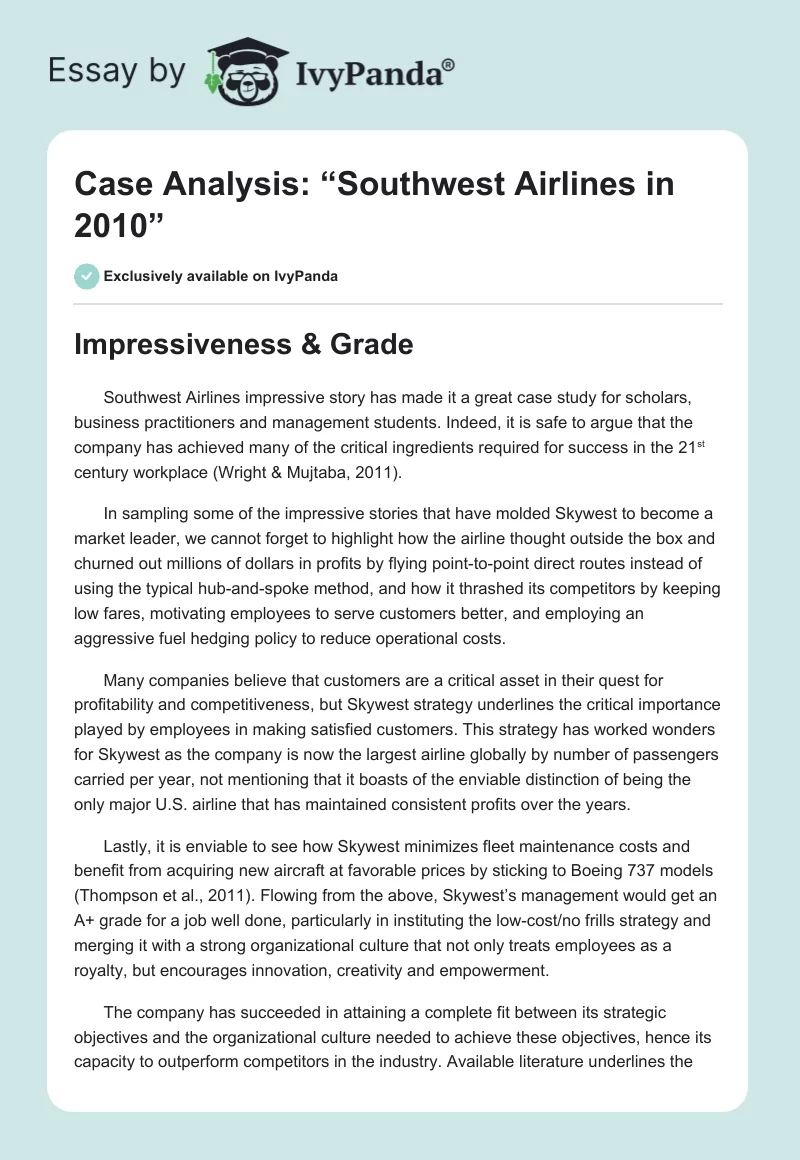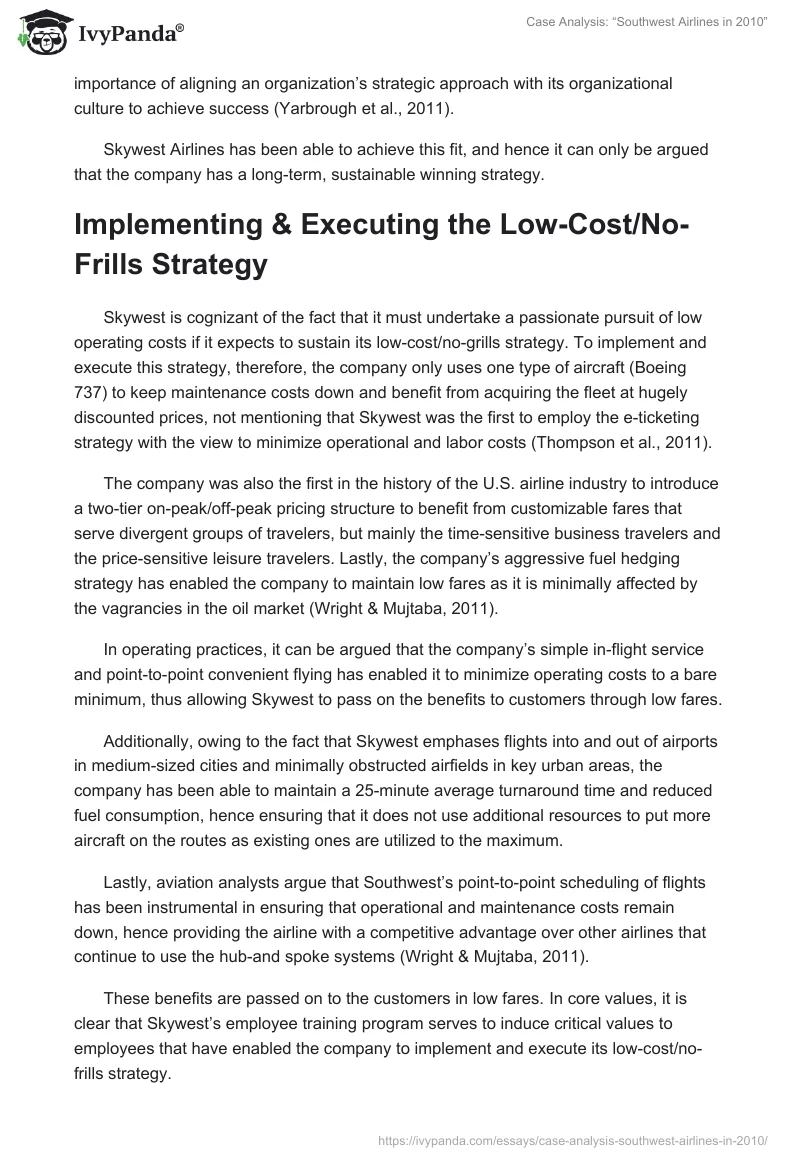Impressiveness & Grade
Southwest Airlines impressive story has made it a great case study for scholars, business practitioners and management students. Indeed, it is safe to argue that the company has achieved many of the critical ingredients required for success in the 21st century workplace (Wright & Mujtaba, 2011).
In sampling some of the impressive stories that have molded Skywest to become a market leader, we cannot forget to highlight how the airline thought outside the box and churned out millions of dollars in profits by flying point-to-point direct routes instead of using the typical hub-and-spoke method, and how it thrashed its competitors by keeping low fares, motivating employees to serve customers better, and employing an aggressive fuel hedging policy to reduce operational costs.
Many companies believe that customers are a critical asset in their quest for profitability and competitiveness, but Skywest strategy underlines the critical importance played by employees in making satisfied customers. This strategy has worked wonders for Skywest as the company is now the largest airline globally by number of passengers carried per year, not mentioning that it boasts of the enviable distinction of being the only major U.S. airline that has maintained consistent profits over the years.
Lastly, it is enviable to see how Skywest minimizes fleet maintenance costs and benefit from acquiring new aircraft at favorable prices by sticking to Boeing 737 models (Thompson et al., 2011). Flowing from the above, Skywest’s management would get an A+ grade for a job well done, particularly in instituting the low-cost/no frills strategy and merging it with a strong organizational culture that not only treats employees as a royalty, but encourages innovation, creativity and empowerment.
The company has succeeded in attaining a complete fit between its strategic objectives and the organizational culture needed to achieve these objectives, hence its capacity to outperform competitors in the industry. Available literature underlines the importance of aligning an organization’s strategic approach with its organizational culture to achieve success (Yarbrough et al., 2011).
Skywest Airlines has been able to achieve this fit, and hence it can only be argued that the company has a long-term, sustainable winning strategy.
Implementing & Executing the Low-Cost/No-Frills Strategy
Skywest is cognizant of the fact that it must undertake a passionate pursuit of low operating costs if it expects to sustain its low-cost/no-grills strategy. To implement and execute this strategy, therefore, the company only uses one type of aircraft (Boeing 737) to keep maintenance costs down and benefit from acquiring the fleet at hugely discounted prices, not mentioning that Skywest was the first to employ the e-ticketing strategy with the view to minimize operational and labor costs (Thompson et al., 2011).
The company was also the first in the history of the U.S. airline industry to introduce a two-tier on-peak/off-peak pricing structure to benefit from customizable fares that serve divergent groups of travelers, but mainly the time-sensitive business travelers and the price-sensitive leisure travelers. Lastly, the company’s aggressive fuel hedging strategy has enabled the company to maintain low fares as it is minimally affected by the vagrancies in the oil market (Wright & Mujtaba, 2011).
In operating practices, it can be argued that the company’s simple in-flight service and point-to-point convenient flying has enabled it to minimize operating costs to a bare minimum, thus allowing Skywest to pass on the benefits to customers through low fares.
Additionally, owing to the fact that Skywest emphases flights into and out of airports in medium-sized cities and minimally obstructed airfields in key urban areas, the company has been able to maintain a 25-minute average turnaround time and reduced fuel consumption, hence ensuring that it does not use additional resources to put more aircraft on the routes as existing ones are utilized to the maximum.
Lastly, aviation analysts argue that Southwest’s point-to-point scheduling of flights has been instrumental in ensuring that operational and maintenance costs remain down, hence providing the airline with a competitive advantage over other airlines that continue to use the hub-and spoke systems (Wright & Mujtaba, 2011).
These benefits are passed on to the customers in low fares. In core values, it is clear that Skywest’s employee training program serves to induce critical values to employees that have enabled the company to implement and execute its low-cost/no-frills strategy.
For instance, the company’s flight attendants have been acculturated to clean up trash left by deplaning customers and otherwise getting the plane presentable for passengers to board for the next flight, hence removing labor costs that could have incurred in engaging the services of cleaning crews. Indeed, rival airlines have been forced to borrow this practice as a viable cost-cutting measure (Thompson et al., 2011).
Southwest’s Culture
Southwest’s corporate culture is guided by three foremost elements – LUV, fun and doing things differently or unconventionally. The company’s culture emphasizes the treatment of individuals, employees and customers with utmost dignity, compassion, love and respect, not mentioning that employees are always motivated through loyalty programs to maintain a fun-filled and entertaining behavioral orientation when interacting with customers.
Undoubtedly, Southwest is a strong culture company as it lays much emphasis on employees to adopt the ‘Southwest way’, which is guided by three elements, namely “…a Warrior Spirit, Servant’s Heart, and Fun-Loving Attitude” (Thompson et al., 2011 p. C304).
Employees who are unable to fulfill these elements are encouraged by management to seek employment elsewhere. However, Gary Kelly may face challenges in recruiting the right kind of personnel to spearhead these three critical elements that inform Skywest’s strong culture and competitive approach.
Grade & Best Execution Approaches
Southwest deserves grade A for aligning its strategic approaches with its corporate culture and employee concerns to achieve operational excellence.
All the strategy execution approaches and operating practices as discussed in section 2 of this paper have been critical in ensuring that the airline remains a market leader in the industry; however, it can be argued that its aggressive fuel hedging and one-plane-fits-all strategies have been influential in minimizing operational and maintenance costs, hence enabling the company to effectively execute its low-cost/no-frills business strategy.
The company’s employee-oriented management style, as well as a relatively happy workforce and strong culture, have also acted to take it to new heights as far as strategy implementation and execution are concerned. However, the company needs to enhance its market share in ever busy terminals to keep in tandem with current trends in the industry.
Weaknesses & Challenges
It is true that some weaknesses and challenges existed as of mid-2010 in terms of unstable global fuel prices, stiff competition, an accident involving a Southwest’s plane which overshot the runaway, as well as negative media publicity arising from Southwest’s failure to conduct mandatory inspections on their aircraft (Thompson et al., 2011). If not adequately addressed, such weaknesses may dent the company’s competitive advantage and safety record.
Southwest’s Acquisition of AirTran & Arising Strategic Issues
The acquisition of AirTran makes good strategic sense for Southwest, especially in its attempt to expand its market share by flying into new locations in the United States, Mexico and the Caribbean. This acquisition will assist Southwest Airline to strategically operate from Atlanta’s Hartsfield-Jackson International Airport, the busiest airport in the United States and the largest domestic hub previously not served by the company, implying more revenues from increased flights.
However, there exist some strategic issues and problems that need to be addressed for this acquisition to be a success. The foremost strategic issue, in my view, revolves around integrating the over 8,000 AirTran’s employees into Southwest’s corporate culture so that these employees could share in the same dreams and aspirations as set out by management.
The second strategic problem is grounded on the fact that Southwest will now have to deal with two types of aircraft models – Boeing 737 and 717s. Such a departure from the ‘one-plane-fits-all philosophy may in the long-term elevate aircraft maintenance costs for the company. Southwest’s management also needs to come up with ways to operate effectively and efficiently in busy, congested airports.
Recommendations for Practice
Consequently, the recommendations arising from this analysis include (1) exposing AirTran’s employees to a rigorous employee training program to internalize the culture and high standards set by Southwest, (2) conducting routine aircraft maintenance practices to avoid negative media publicity, (3) modifying the acquired AirTran facilities and aircraft to meet the safety standards set by Southwest, (4) investing more resources into talent management, innovation and creativity, training and development, as well as leadership development, and (5) continuing with the low-cost/no-frills strategy as Southwest Airlines chart its way into the future (Crews, 2010).
References
Crews, D.E. (2010). Strategies for implementing sustainability: Five leadership strategies. SAM Advanced Management Journal, 75(2), 15-21.
Thompson, A., Peteraf, M., Gamble, J., & Strickland, A.J. (2011). Crafting and executing strategy: The quest for competitive advantage: Concept and cases (18th ed.). New York, NY: McGraw-Hill/Irwin.
Wright, A., & Mujtaba, B.G. (2011). Southwest Airlines and management: Becoming an industry leader in the modern workplace. Journal of Research in International Business & Management, 1(4), 77-84. Web.
Yarbrough, L., Morgan, N., & Vorhies, D. (2011). The impact of product market strategy-organizational culture fit on business performance. Journal of the Academy of Marketing Science, 39(4), 555-573.


